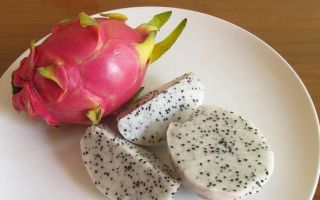Content
- 1 What does pitahaya look like and how it grows
- 2 What taste and smell does dragon fruit have?
- 3 The chemical composition and calorie content of pitahaya
- 4 Why is pitahaya useful?
- 5 How to peel, cut and eat pitahaya
- 6 The harm of pitahaya and contraindications
- 7 How to choose the right dragon fruit
- 8 How to grow pitahaya at home
- 9 Conclusion
- 10 Reviews
Pitaya is an exotic fruit from Thailand that is not often found in Russian stores. It has several names, among which dragon fruit sounds most often. The article will help you figure out what the benefits and harms of pitahaya are, will reveal the secrets of its proper use.
What does pitahaya look like and how it grows
Pitahaya is the fruit of plants representing the cactus of the genus Hilocereus. This is a climbing epiphytic liana-like plant, common in the countries of Central and South America, Mexico.
The dragon fruit has an oval shape, the size of a large apple and weighs from 100 g to 1 kg. The fruit is covered with a yellow or pink scaly skin, has white or light pink flesh, with small black seeds. In structure, the pulp of pitahaya is comparable to kiwi.
Today, fruits with white, yellow and pink colors are known.

What taste and smell does dragon fruit have?
Dragon fruit has a neutral to sweetish taste. Despite the freshness, there are quite juicy fruits (for example, red pitahaya with white flesh).
Dragon fruit has a light characteristic aroma, vaguely reminiscent of the smell of bananas, kiwi and herbs.
The chemical composition and calorie content of pitahaya
The calorie content of pitahaya per 100 g is only 50 kcal. Its chemical composition includes the following components:
|
Protein |
500 mg |
|
Fats |
300 m |
|
Carbohydrates |
12 g |
|
Cellulose |
700 mg |
|
Ash |
500 mg |
|
A nicotinic acid |
0.3 mg |
|
Vitamin C |
9 mg |
|
Calcium |
7 mg |
|
Phosphorus |
30 mg |
|
Iron |
0.55 mg |
|
Carotene |
0.012 mg |
|
Thiamine |
0.30 mg |
|
Riboflavin |
0.45 mg |
|
Vitamin E |
0.08 mg |
Why is pitahaya useful?
The dragon eye is known as a fruit with many health benefits. It contains vitamins and minerals that have a positive effect on the functioning of the immune system. People with indigestion or intestinal upset use pitahaya to help normalize digestion and the process of breaking down lipids.
The small black seeds of the fruit pulp contain a large amount of fat-containing compounds involved in the creation of cell membranes. They are rich in fatty acids that reduce the amount of "bad" cholesterol in the blood. However, in order for the seeds to show their positive properties, they must be thoroughly chewed.
The thiamine contained in fruits contributes to the normal functioning of the cardiovascular and nervous system. The specified vitamin is necessary for people who are faced with high physical exertion to increase muscle tone.
Pitahaya is rich in fiber, which helps to slow down the breakdown of sucrose. The GI (glycemic index) of the product is quite low. This is especially important for those with type 2 diabetes.
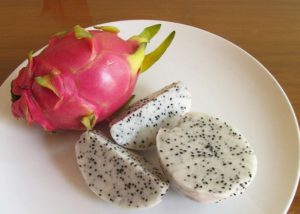
Pitahaya fruits cleanse internal organs of toxins. Antioxidants, which are included in their composition, help to eliminate free radicals from the body.
Dragon fruit tones and moisturizes the skin, is actively used in the field of cosmetology.
Doctors strongly recommend that pregnant women introduce this healthy fruit into their diet, as the beneficial ingredients have a beneficial effect on the health of the fetus and woman.
In cooking, pitahaya is used as one of the components of fruit salads, desserts, smoothies and ice cream. Combinations of fruit with banana, pineapple, muesli are useful and tasty.
For example, a smoothie made from fruit pulp with apple and lemon juice, a small amount of spinach and grated ginger - a storehouse of vitamins and biologically active substances is useful both for enhancing immunity and for preventing weight loss. Another interesting dessert is popsicles with the addition of pitahaya. A peculiar rich pink color with small inclusions of black seeds, a pleasant taste - will not leave indifferent either children or adults.
Dragon fruit fully tones and moisturizes the skin, it is actively used in cosmetology as ingredients in tonics, gels, face and body creams. At home, a good morning tonic would be ice cubes with pitahaya juice. A scrub version of an exfoliating product using fruit is also interesting. Soft and gentle cleansing of the skin is combined with its saturation with vitamins and other useful components.
How to peel, cut and eat pitahaya
Peeling and consuming dragon fruit is quite simple:
- starting from the top of it, carefully remove the peel with your hands. The inside can be eaten like a regular apple;
- cut the fruit into slices;
- make a large incision around the entire perimeter of the fruit and slowly cut off the skin without affecting the flesh;
- cut the pitahaya in two and consume the pulp with a spoon.
As a rule, dragon fruit is eaten fresh, without any processing. In some countries, jam, yogurt, jelly, candies, etc. are made on its basis. It is also used as an ingredient for alcoholic beverages.
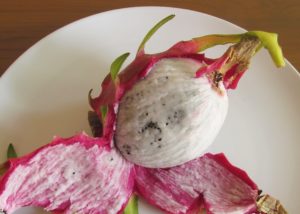
How to eat pitahaya correctly, you can look at (video):
The harm of pitahaya and contraindications
In some cases, pitahaya can bring both harm and benefit to the body. If you stick to a balanced diet, the fetus has practically no negative effect on human health. The only serious contraindication is individual fruit intolerance.
It should be noted that after a person eats a red pitahaya, his urine becomes red. This is due only to the high content of pigments in the composition of the product and does not have a negative effect on the body.
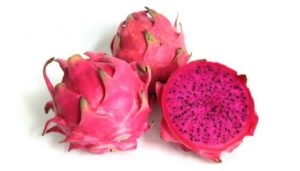
How to choose the right dragon fruit
When buying dragon fruit, pay attention to the rind first. Bright colors with a slight sheen and yellow-green scales indicate the maturity of the fruit. If the color is uneven, then the fruit is not yet ripe and should not be taken.
Fruit that is too hard or soft is also a bad sign. Ripe and tasty, it should feel like a kiwi to the touch.
How to grow pitahaya at home
Pitahaya is the fruit of a plant that is not too picky about keeping conditions. Therefore, it can be easily grown at home. The dragon fruit grows well in a warm and bright room, however, it can withstand colder temperatures and occasional darkening.
To grow pitahaya, you need to germinate its seeds (small blotches that are contained in the pulp of the fruit). For this, a slightly damp gauze cloth is used, into which the seeds are placed. When they germinate, they are planted in the ground and the seedlings are placed on a lighted windowsill.
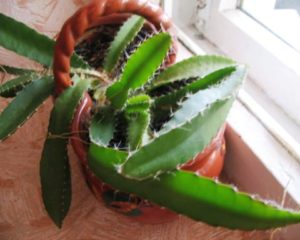
Shoots tend to grow and develop quickly. During the year, they reach about 80 cm in height.The plant must be regularly watered and fertilized with nitrogenous mineral components.
Conclusion
The benefits and harms of pitahaya depend on the regularity of use. Eating dragon fruit on a regular basis will have positive health effects. However, excessive consumption of fruits is highly undesirable.

